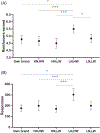The interaction of nicotine concentration and device power on electronic nicotine delivery system (ENDS) abuse liability among exclusive ENDS users and dual users of ENDS and combustible cigarettes
- PMID: 34647773
- PMCID: PMC9284402
- DOI: 10.1037/pha0000523
The interaction of nicotine concentration and device power on electronic nicotine delivery system (ENDS) abuse liability among exclusive ENDS users and dual users of ENDS and combustible cigarettes
Abstract
Open-system electronic nicotine delivery systems (ENDS) permit modifications to device characteristics such as power, potentially increasing nicotine and toxicant delivery. Limiting liquid nicotine concentration may carry unintended consequences by prompting users to increase device power to increase nicotine delivery. This study examined the abuse liability of ENDS across nicotine concentration and power settings. In a clinical laboratory study, n = 19 exclusive ENDS users and n = 13 dual ENDS/cigarette users, aged 21-55 completed four Latin-square ordered conditions that varied by liquid nicotine concentration (10 mg/ml [low], 30 mg/ml [high]) and device power (15 watts [low], 30 watts [high]), that were followed by a fifth own brand (OB) condition. A progressive ratio task (PRT) using bar presses to earn ENDS puffs was used to assess abuse liability and compare between conditions using mixed effects linear regressions. The low nicotine/high watt condition was associated with a significantly higher number of bar presses and puffs earned relative to the OB ENDS, high nicotine/high watt, and high nicotine/low watt conditions (p < .05). Findings appeared to be driven largely by exclusive ENDS users; most comparisons were not significant among dual users. Participants worked significantly harder for puffs of low nicotine/high watt ENDS, highlighting previous findings that suggest limiting liquid nicotine concentration without addressing power settings may be insufficient to reduce the abuse liability of ENDS. (PsycInfo Database Record (c) 2022 APA, all rights reserved).
Trial registration: ClinicalTrials.gov NCT03830892.
Figures


References
MeSH terms
Substances
Associated data
Grants and funding
LinkOut - more resources
Full Text Sources
Medical
Miscellaneous

